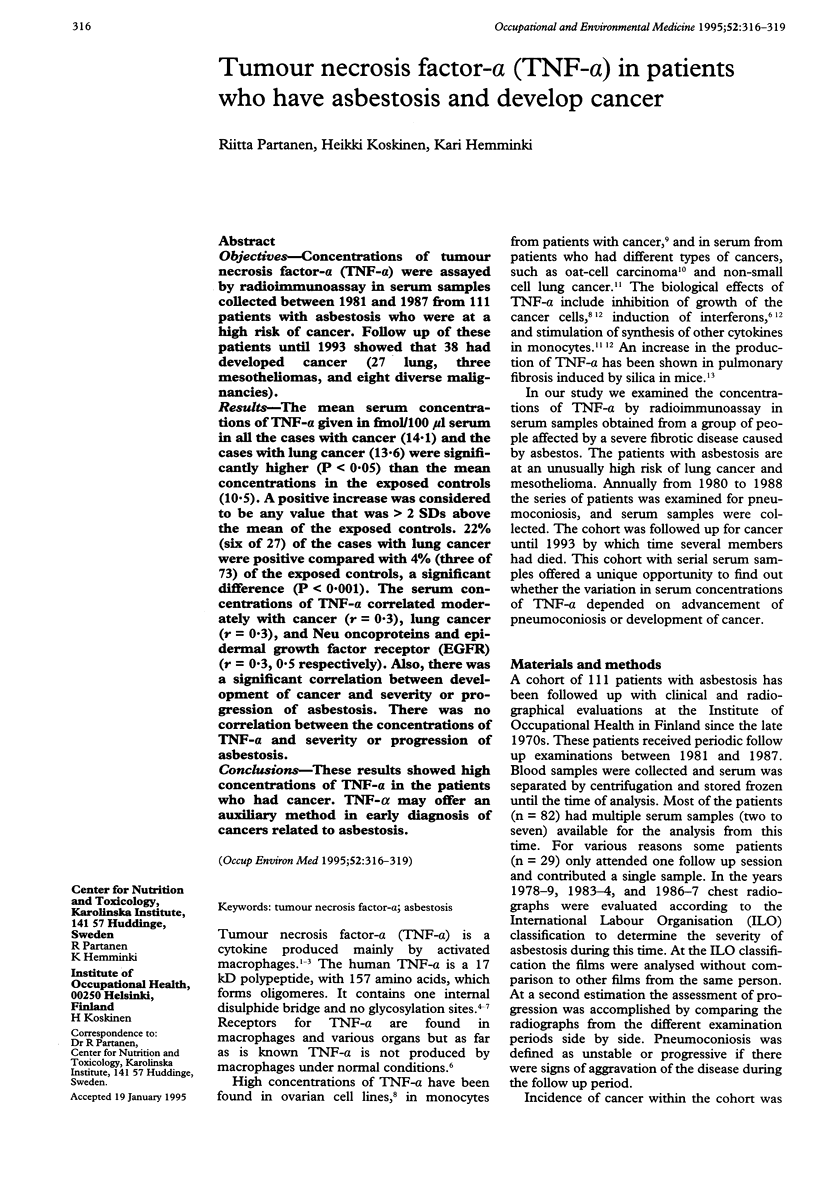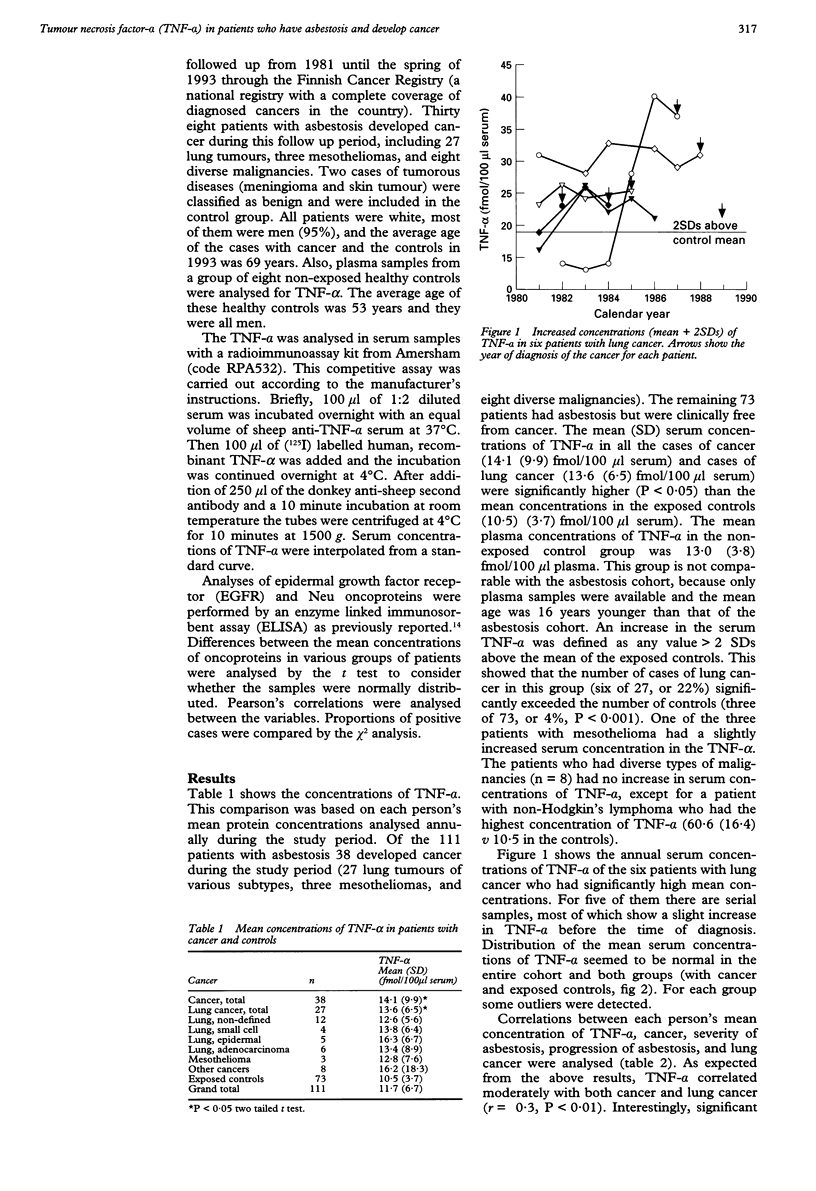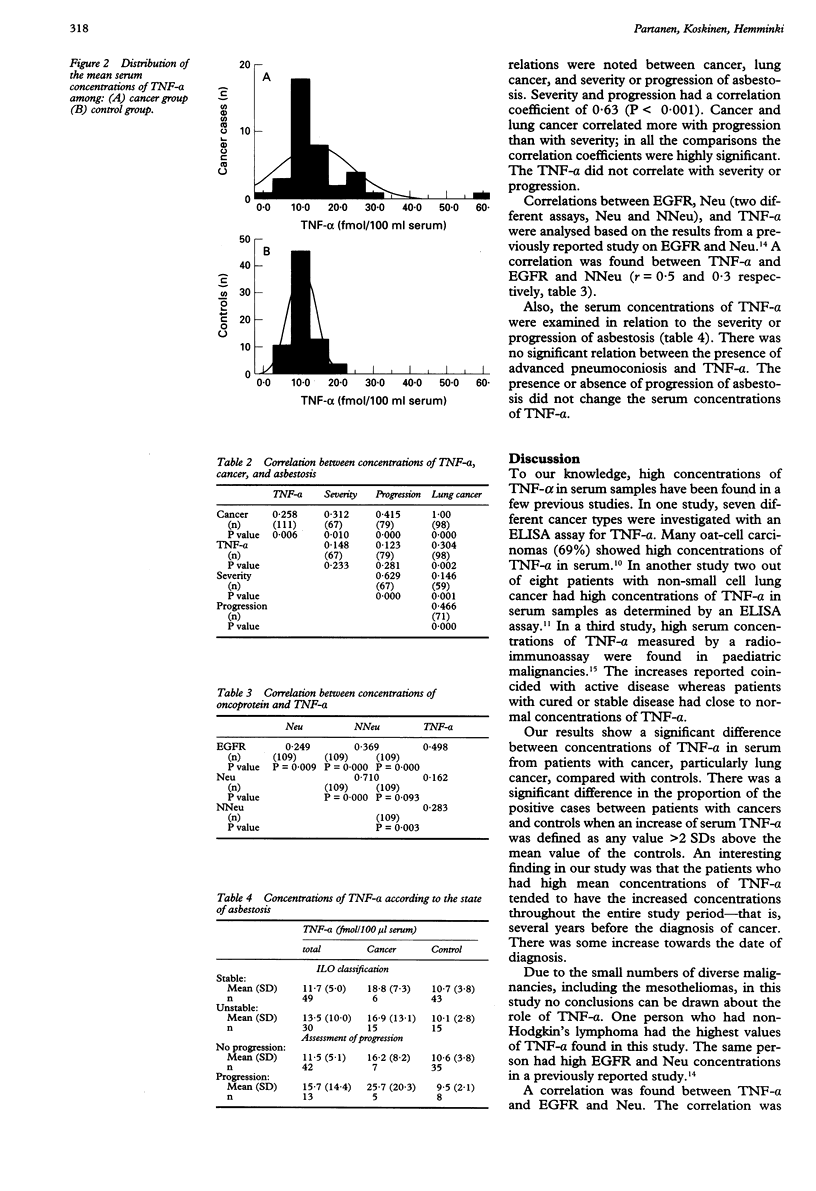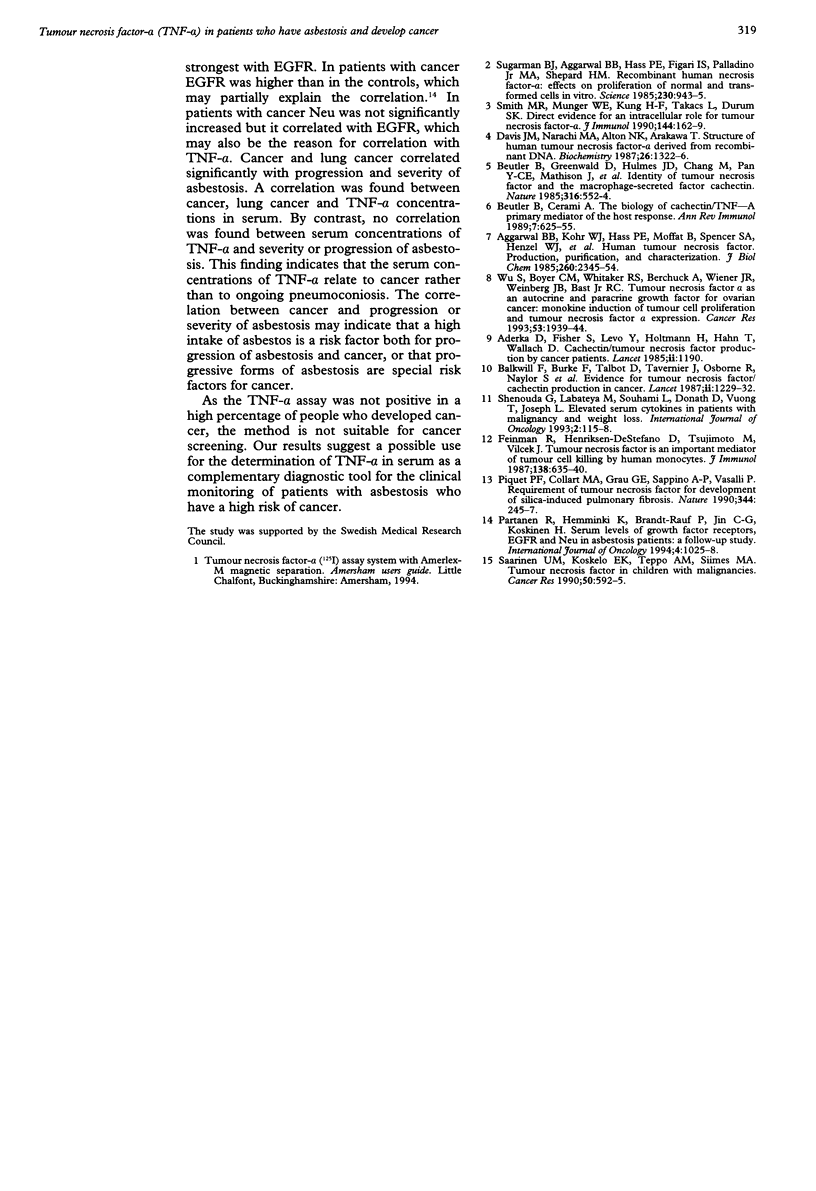Abstract
OBJECTIVES--Concentrations of tumour necrosis factor-alpha (TNF-alpha) were assayed by radioimmunoassay in serum samples collected between 1981 and 1987 from 111 patients with asbestosis who were at a high risk of cancer. Follow up of these patients until 1993 showed that 38 had developed cancer (27 lung, three mesotheliomas, and eight diverse malignancies). RESULTS--The mean serum concentrations of TNF-alpha given in fmol/100 microliters serum in all the cases with cancer (14.1) and the cases with lung cancer (13.6) were significantly higher (P < 0.05) than the mean concentrations in the exposed controls (10.5). A positive increase was considered to be any value that was > 2 SDs above the mean of the exposed controls. 22% (six of 27) of the cases with lung cancer were positive compared with 4% (three of 73) of the exposed controls, a significant difference (P < 0.001). The serum concentrations of TNF-alpha correlated moderately with cancer (r = 0.3), lung cancer (r = 0.3), and Neu oncoproteins and epidermal growth factor receptor (EGFR) (r = 0.3, 0.5 respectively). Also, there was a significant correlation between development of cancer and severity or progression of asbestosis. There was no correlation between the concentrations of TNF-alpha and severity or progression of asbestosis. CONCLUSIONS--These results showed high concentrations of TNF-alpha in the patients who had cancer. TNF-alpha may offer an auxiliary method in early diagnosis of cancers related to asbestosis.
Full text
PDF



Selected References
These references are in PubMed. This may not be the complete list of references from this article.
- Aderka D., Fisher S., Levo Y., Holtmann H., Hahn T., Wallach D. Cachectin/tumour-necrosis-factor production by cancer patients. Lancet. 1985 Nov 23;2(8465):1190–1190. doi: 10.1016/s0140-6736(85)92713-8. [DOI] [PubMed] [Google Scholar]
- Aggarwal B. B., Kohr W. J., Hass P. E., Moffat B., Spencer S. A., Henzel W. J., Bringman T. S., Nedwin G. E., Goeddel D. V., Harkins R. N. Human tumor necrosis factor. Production, purification, and characterization. J Biol Chem. 1985 Feb 25;260(4):2345–2354. [PubMed] [Google Scholar]
- Balkwill F., Osborne R., Burke F., Naylor S., Talbot D., Durbin H., Tavernier J., Fiers W. Evidence for tumour necrosis factor/cachectin production in cancer. Lancet. 1987 Nov 28;2(8570):1229–1232. doi: 10.1016/s0140-6736(87)91850-2. [DOI] [PubMed] [Google Scholar]
- Beutler B., Cerami A. The biology of cachectin/TNF--a primary mediator of the host response. Annu Rev Immunol. 1989;7:625–655. doi: 10.1146/annurev.iy.07.040189.003205. [DOI] [PubMed] [Google Scholar]
- Beutler B., Greenwald D., Hulmes J. D., Chang M., Pan Y. C., Mathison J., Ulevitch R., Cerami A. Identity of tumour necrosis factor and the macrophage-secreted factor cachectin. Nature. 1985 Aug 8;316(6028):552–554. doi: 10.1038/316552a0. [DOI] [PubMed] [Google Scholar]
- Davis J. M., Narachi M. A., Alton N. K., Arakawa T. Structure of human tumor necrosis factor alpha derived from recombinant DNA. Biochemistry. 1987 Mar 10;26(5):1322–1326. doi: 10.1021/bi00379a018. [DOI] [PubMed] [Google Scholar]
- Feinman R., Henriksen-DeStefano D., Tsujimoto M., Vilcek J. Tumor necrosis factor is an important mediator of tumor cell killing by human monocytes. J Immunol. 1987 Jan 15;138(2):635–640. [PubMed] [Google Scholar]
- Piguet P. F., Collart M. A., Grau G. E., Sappino A. P., Vassalli P. Requirement of tumour necrosis factor for development of silica-induced pulmonary fibrosis. Nature. 1990 Mar 15;344(6263):245–247. doi: 10.1038/344245a0. [DOI] [PubMed] [Google Scholar]
- Saarinen U. M., Koskelo E. K., Teppo A. M., Siimes M. A. Tumor necrosis factor in children with malignancies. Cancer Res. 1990 Feb 1;50(3):592–595. [PubMed] [Google Scholar]
- Smith M. R., Munger W. E., Kung H. F., Takacs L., Durum S. K. Direct evidence for an intracellular role for tumor necrosis factor-alpha 1. Microinjection of tumor necrosis factor kills target cells. J Immunol. 1990 Jan 1;144(1):162–169. [PubMed] [Google Scholar]
- Sugarman B. J., Aggarwal B. B., Hass P. E., Figari I. S., Palladino M. A., Jr, Shepard H. M. Recombinant human tumor necrosis factor-alpha: effects on proliferation of normal and transformed cells in vitro. Science. 1985 Nov 22;230(4728):943–945. doi: 10.1126/science.3933111. [DOI] [PubMed] [Google Scholar]
- Wu S., Boyer C. M., Whitaker R. S., Berchuck A., Wiener J. R., Weinberg J. B., Bast R. C., Jr Tumor necrosis factor alpha as an autocrine and paracrine growth factor for ovarian cancer: monokine induction of tumor cell proliferation and tumor necrosis factor alpha expression. Cancer Res. 1993 Apr 15;53(8):1939–1944. [PubMed] [Google Scholar]


